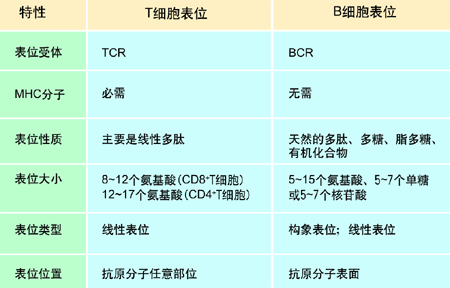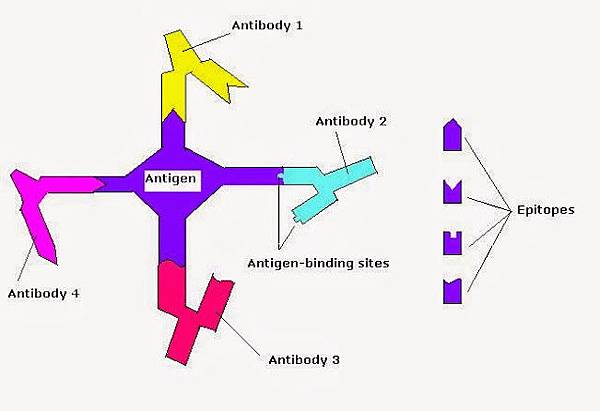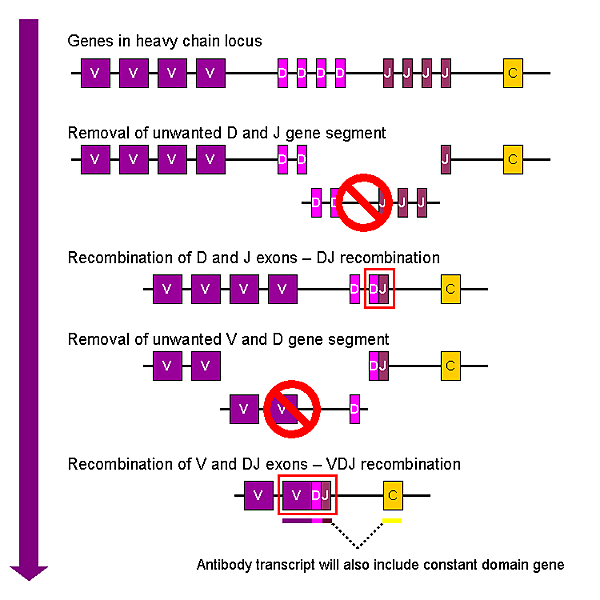








Epitope:Antigenic determinant抗原決定位、抗原表位
Epitope, also known as Antigenic determinant, is the part of an antigen that is recognized by the immune system, specifically by antibodies, B cells, or T cells. The part of an antibody that recognizes the epitope is called a Paratope. Although epitopes are usually non-self proteins, sequences derived from the host that can be recognized are also epitopes.
The epitopes of protein antigens are divided into two categories, Conformational epitopes and Linear epitopes, based on their structure and interaction with the paratope. A conformational epitope is composed of discontinuous sections of the antigen's amino acid sequence. These epitopes interact with the paratope based on the 3-D surface features and shape or tertiary structure of the antigen. The proportion of epitopes that are conformational is unknown.
By contrast, linear epitopes interact with the paratope based on their primary structure. A linear epitope is formed by a continuous sequence of amino acids from the antigen.
Epitope抗原決定位、抗原表位:是指抗原表面上決定抗原特異性的化學基團。
抗原表位可被免疫系統(尤其是抗體、B細胞或者T細胞)所識別。抗體中能識別抗原表位的區域叫做「互補位」或「抗體決定簇」(Paratope)。儘管通常抗原表位是指外來蛋白質等物質的其中一部分,但只要能被自身免疫系統所識別的表位,也被歸為抗原表位。
蛋白質抗原的表位根據它們的結構以及與互補位的交互作用,被分為構象表位Conformational epitopes和線性表位Linear epitopes這兩種類型。其中構象表位有抗原胺基酸序列中的不連續部分組成,因此互補位和抗原表位的交互作用是基於表面的三位特徵和形狀,或者是抗原的三級結構。大部分的抗原表位都屬於構象表位。與此相反,線性表位是由一段連續的抗原胺基酸序列構成,與抗原的交互作用的基礎是其一級結構。
抗原被抗体辨識或結合的地方叫抗原決定位antigenic determinant或epitope。
抗原上的決定位通常含6~8個胺基酸,它可以是三度空間的構造conformation structure,如抗体結合到蛋白質暴露在外面的位置,如果將蛋白質變性,另一種抗原決定位是二度空間的構造sequence determinant,T-細胞所辨認的抗原決定位,便是此種一連串胺基酸組成的抗原決定位,它和主要組織相容抗原(Major histocompatibility complex;MHC)上的class I/II在一起,而與T-細胞上的T-細胞受器(T cell receptor,TCR)結合,一個抗原通常有好幾個抗原決定位,構造越複雜,分子量越大,它的抗原決定位愈多。T-細胞和B-細胞辨認的抗原決定位可以是不同的。



 留言列表
留言列表
